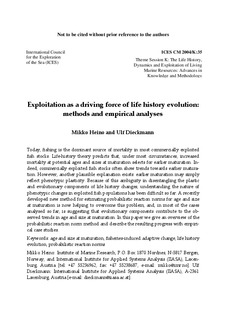| dc.contributor.author | Heino, Mikko | |
| dc.contributor.author | Dieckmann, Ulf | |
| dc.date.accessioned | 2007-07-11T12:25:54Z | |
| dc.date.issued | 2004 | |
| dc.identifier.uri | http://hdl.handle.net/11250/100615 | |
| dc.description.abstract | Today, fishing is the dominant source of mortality in most commercially exploited fish stocks. Life-history theory predicts that, under most circumstances, increased mortality at potential ages and sizes at maturation selects for earlier maturation. In-deed, commercially exploited fish stocks often show trends towards earlier matura-tion. However, another plausible explanation exists: earlier maturation may simply reflect phenotypic plasticity. Because of this ambiguity in disentangling the plastic and evolutionary components of life history changes, understanding the nature of phenotypic changes in exploited fish populations has been difficult so far. A recently developed new method for estimating probabilistic reaction norms for age and size at maturation is now helping to overcome this problem, and, in most of the cases analysed so far, is suggesting that evolutionary components contribute to the ob-served trends in age and size at maturation. In this paper we give an overview of the probabilistic reaction norm method and describe the resulting progress with empiri-cal case studies. | en |
| dc.format.extent | 211302 bytes | |
| dc.format.mimetype | application/pdf | |
| dc.language.iso | eng | en |
| dc.publisher | ICES | en |
| dc.relation.ispartofseries | ICES CM documents | en |
| dc.relation.ispartofseries | 2004/K:35 | en |
| dc.subject | exploitation | en |
| dc.subject | beskatning | |
| dc.title | Exploitation as a driving force of life history evolution: methods and empirical analyses | en |
| dc.type | Working paper | en |
| dc.subject.nsi | VDP::Mathematics and natural science: 400::Zoology and botany: 480::Ecology: 488 | |
| dc.subject.nsi | VDP::Agriculture and fishery disciplines: 900::Fisheries science: 920::Resource biology: 921 | |
| dc.source.pagenumber | 7 s. | en |
